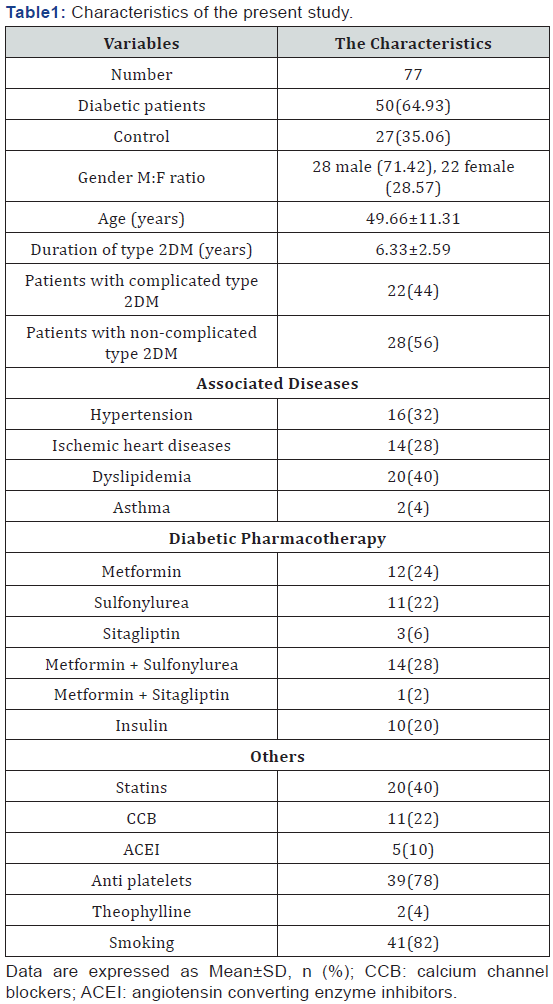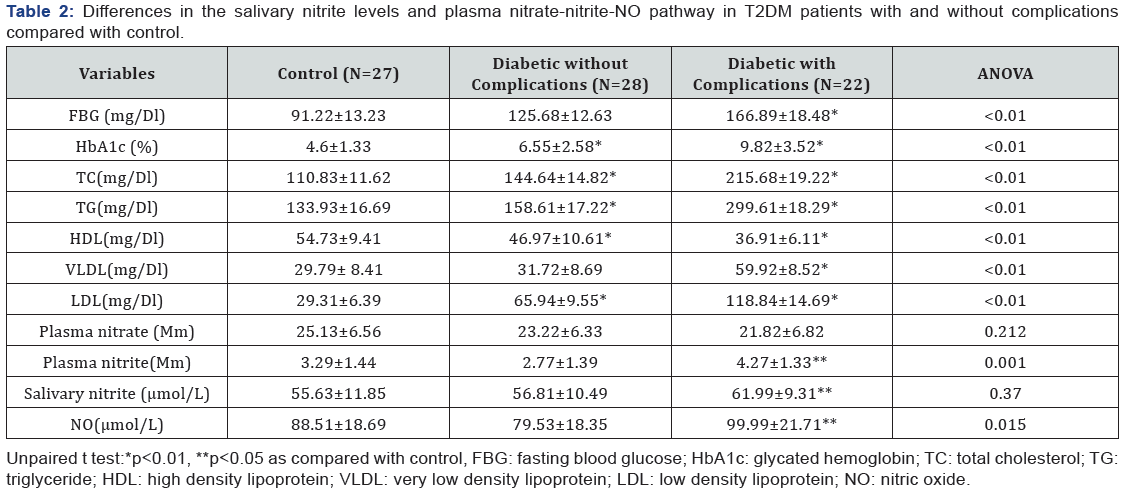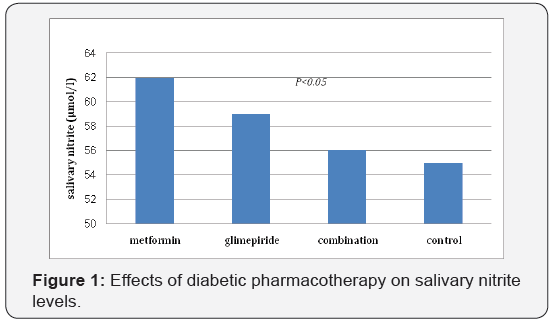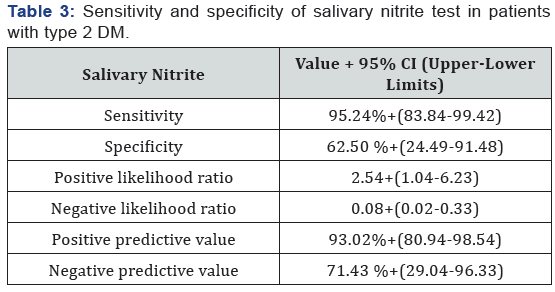Salivary Nitrite in Patients with Type 2 Diabetes Mellitus: Role of Diabetic Pharmacotherapy-Juniper Publishers
JUNIPER PUBLISHERS-OPEN ACCESS GLOBAL JOURNAL OF PHARMACY & PHARMACEUTICAL SCIENCES
Salivary nitrite is derived from salivary nitrate
that obtained from ingested nitrate since 25% of nitrate is secreted
through saliva thus; salivary nitrate is 10-20 times higher than plasma
nitrate. Nitrate-nitric-NO pathway plays a role in prevention of insulin
resistance and progression of diabetes mellitus. Because of salivary
nitrite is also generated from NO metabolism therefore, salivary nitrite
may reflect the endogenous NO production and endothelial function in
various diseases thus; the aim of present study was evaluation of
salivary nitrite in controlled and complicated T2DM regarding the
current diabetic pharmacotherapy. In this study a total number of 50
patients with T2DM were selected randomly compared with 27 healthy
subjects. 10ml of venous blood from all patients and healthy subjects
after an overnight fasting was drawn, lipid profile, fasting blood
glucose, plasma nitrate, plasma nitrite, nitric oxide NO and salivary
nitrite were determined in patients with T2DM regarding specific
diabetic pharmacotherapy and complications compared to healthy control.
Salivary nitrite was high in patient with complications p=0.04 compared
with control and near normal in diabetic patient without complications.
Metformin increases salivary nitrite more than glimepiride but
combination of metformin plus glimepiride produced significant
amelioration in salivary nitrite levels.
Conclusion: Salivary nitrite levels
were high in complicated T2DM and low in controlled T2DM compared to the
control. Metformin increases salivary nitrite levels whereas
glimepiride alone or in combination with metformin reduce salivary
nitrite levels in T2DM patients.
Keywords: Salivary nitrite; Metformin; glimepiride; T2DMAbbreviations: T2DM: Type 2 Diabetes Mellitus; MIP: Macrophage Inflammatory Protein; GLUT4: Glucose Transporter 4; VEGF: Vascular Endothelial Growth Factor
Introduction
Type 2 diabetes mellitus (T2DM) is an endocrine and
metabolic disorder characterized by hyperglycemia and inflammatory
changes that cause systemic complications due to nitric oxide disorders
that cause endothelial dysfunction [1]. Inorganic nitrite and nitrate
are found in vegetable food and drinking water, this nitrate/nitrite
compounds are responsible for restoring of nitric oxide NO which play an
important role in prevention of insulin resistance and development of
T2DM [2]. Previously, nitrate/nitrite compounds were reported to be a
risk factor in development of T2DM [3]. Salivary nitrite is derived from
salivary nitrate that obtained from ingested nitrate since 25% of
nitrate is secreted through saliva thus; salivary nitrate
is 10-20 times higher than plasma nitrate [4]. Moreover, nitrite is
responsible for synthesis of NO via independent-nitric oxide synthase
pathway that called nitrate-nitric-NO pathway, so diet deficient nitrate
lead to cardiac and hepatic damage due to ischemic-reperfusion injury
[5].
of insulin resistance [6]. Indeed, the impact of T2DM on NO
production is revealed through different mechanisms which are:
- Longstanding hyperglycemia leads to induction of oxidative stress and buildup of advance glycation end products that inhibit nitrate-nitric-NO pathway [7].
- Chronic hyperglycemia induces production of dimethylarginine which inhibit nitrate-nitric-NO pathway [8].
- Stimulation of arginase activity that decrease the availability of arginine for NO synthesis [9].
- Inhibition of NO synthesis due to insulin impairment [10].
Regarding diabetic pharmacotherapy, metformin is a
biguanide approved for management of T2DM, it possess
significant anti-inflammatory and anti-oxidant effects that
reducing the cardio-metabolic complications [11], additionally,
metformin improves endothelial function through regulation
of endothelial NO and attenuating the inflammatory-induced
vascular endothelial function [12]. Alternatively, glimepiride
which is a long acting secretagogus sulfonylurea acts through
augmentation of peripheral insulin sensitivity and stimulation
of insulin secretion from pancreatic β-cells [13]. Generally,
sulfonylurea reduced NO production [14] but it is little known
about glimepiride effect on nitrate-nitric-NO pathway. Because
of salivary nitrite is also generated from NO metabolism
therefore, salivary nitrite may reflect the endogenous NO
production and endothelial function in various diseases thus;
the aim of present study was evaluation of salivary nitrite in
controlled and complicated T2DM regarding the current diabetic
pharmacotherapy.
Materials and Methods
In this observational study a total number of 50 patients
with T2DM were selected randomly from Iraqi endocrinology
center, compared with 27 healthy subjects. Moreover, T2DM
patients were subdivided into two groups: group 1 involved
22(44%) patients with diabetic complications; group 2 involved
28 (56) % patients without complications. All patients and
control subjects gave a verbal consent for their participation in
this study. This study was approved by scientific jury and ethical
committee. A full history was been undertaken for all patients
regarding disease duration, current pharmacotherapy, dietary
schedule (avoiding high nitrate food for 12 prior to the test) and
associated diseases, and any patient with end stage or severe
complications were excluded .
Biochemical measurements
10ml of venous blood from all patients and healthy subjects
after an overnight fasting was drawn, after centrifugation the sera
were stored at -20°C for analysis. Lipid profile was estimated by
specific kit method according to the kit instructions; VLDL and
LDL were estimated according to specific formula [15]. Fasting blood glucose was determined by fasting capillary method [16].
Plasma nitrate, plasma nitrite in μM and nitric oxide NO μmol/L
was determined according to the specific method [17]. Direct
strip method was used for estimation of salivary nitrite (μmol/L)
according to the specific method [18]. the samples are taken at
8.00 am and immediately used to avoid the diurnal variations.
Statistical analysis
Data of the present study were expressed as mean±
SD, percentages and numbers. Unpaired t test was used for
determination the significance of differences compared with
control, whereas ANOVA test was used to detects the significance
of differences among the diabetic patients and control subjects,
regarding p is significant when it <0.05. SPSS version 21 was
used for analysis the data of the present study.
Results

A total number of 50 patients compared with 27 normal
healthy subjects were included in this study. The duration of
T2DM was 6.33±2.59 years, 44% of diabetic patients (n=22)
presented with complications whereas; 56% of diabetic
patients (n=28) not associated with diabetic complications. The
associated diseases with T2DM in this study were hypertension16
(32%), ischemic heart diseases 14(28%), dyslipidemia20
(40%) and asthma 2(4%). Most of diabetic patients were
on current therapy of metformin 24% and metformin plus
sulfonylurea 28% also, 82% of diabetic patients (n=41) were
smokers. Other treatments that are received by the diabetic
patients were calcium channel blockers, angiotensin converting
enzyme inhibitors, statins, antiplatelets and theophylline, Table
1 showed the characteristics of enrolled patients. In T2DM
patients without complications there was well-controlled fasting
blood glucose, HbA1c p>0.05 as compared with control but in
those patients there is dyslipidemic state p<0.05 compared with
control without significance of differences regarding plasma
nitrate, plasma nitrite, salivary nitrite and endogenous NO levels
p>0.05 compared with control.


In T2DM patients with complications there were significant
hyperglycemia, dyslipidemia, elevated plasma nitrite, reduced
plasma nitrate, elevated salivary nitrite and elevated endogenous
NO levels therefore; salivary nitrite was high in patient with
complications p=0.04 compared with control and near normal in
diabetic patient without complications (Table 2). Regarding the
diabetic pharmacotherapy, metformin increases salivary nitrite
more than glimepiride but combination of metformin plus
glimepiride produced significant amelioration in salivary nitrite
levels. In the present study most of diabetic patients without
complications were on combination therapy whereas most of
diabetic patients with complications were on monotherapy of either metformin or glimepiride (Figure 1). Regarding the
significance value of salivary nitrite test in this study it was
highly sensitive with moderate specificity with comparable
positive and negative predictive value (Table 3).

Discussion
The present study illustrated that salivary nitrite was low
in patients with controlled T2DM and high in T2DM patients
with complications compared with normal healthy control
subjects, these findings were corresponded with Francesconi,
et al. [19] study that showed changes in nitrate and nitrate
levels may reflect the endogenous NO production and metabolic
alterations induced by hyperglycemia [19] Moreover , elevation
and reduction in nitrate and nitrite levels were revealed in T2DM compared with control due to metabolic disturbances
and diabetic-induced complications such as nephropathy that
causing significant elevation in nitrate/nitrite levels due to
activation of inducible NO synthase enzyme, inflammatory
changes and insulin resistance [20].
Indeed, changes in salivary nitrite in the patients with T2DM
may be due to diabetic-induced alterations in the salivary flow
and compositions [21]. Results of present study as well showed
significant changes in NO serum levels , high in complicated
and low in non-complicated T2DM since; increased nitrate/
nitrite plasma levels with increased NO production could be
a compensatory mechanism against insulin resistance and
diabetic-induced oxidative stress [22] thus; augmented nitratenitrite-
NO pathway was reflected via increasing in the salivary
nitrite levels whereas ;well controlled diabetic patients exhibited
low nitrate/nitrite levels [23].
Moreover, the present study showed that diabetic-induced
dyslipiemia was more observed in patients with complicated
T2DM, this dyslipidemia may affect the endothelial function
and NO production [24]. Therefore, augmentation in the nitrite/
nitrate plasma levels in complicated T2DM could have a beneficial
effect in prevention the progression of diabetic complications
since; plasma nitrite/nitrate has interesting antioxidant and
anti-inflammatory actions that ameliorate endogenous catalase
and glutathione activity as well as improves the level of proinflammatory
cytokines [25].
On the other hand, 81% of recruited patients were
smokers
that may affect the nitrite/nitrate/NO pathway as illustrated by
Retterstol, et al. [26] study that showed low level of nitrate and
nitrite levels in smokers healthy subjects [26] but in our study high
level of nitrite/nitrate/NO pathway was showed in complicated
T2DM smoker patients since; chronic nicotine smoking leads
to significant endothelial dysfunction [27]. Regarding T2DM
pharmacotherapy in the present study, most of patients were
treated by either metformin and/or glimepiride these agents
may also affect nitrite/nitrate/NO pathway seeing as; metformin
improves endothelial function in T2DM patients that reflected
by increase in the NO levels with subsequent augmentation in
nitrite/nitrate plasma levels that excreted though salivary rout
as salivary nitrite [28,29] thus; metformin improves NO through
AMP-activated protein kinase activation that responsible for up
regulation of eNOS and then NO production and inhibition of
Rho kinas which implicated in the development of endothelial
dysfunction and reduction of endothelial NO production [30].
Indeed, glimepiride have potent anti-inflammatory and antioxidant
activities through reduction of vascular endothelial
growth factor (VEGF) and macrophage inflammatory protein
(MIP) that contributes into prevention of diabetic-induced
endothelial dysfunction and the alteration in the NO production
[31] Furthermore, salivary nitrite in the present study was
highly sensitive but less specific with high positive predicative
value since; all samples were taken at morning and immediately used for
analysis in view of the fact that salivary nitrite levels are
highs affected by sample time, storage and analysis time [32,33].
Conclusion
Salivary nitrite levels were high in complicated T2DM and
low in controlled T2DM compared to the control. Metformin
increases salivary nitrite levels whereas glimepiride alone or
in combination with metformin reduce salivary nitrite levels in
T2DM patients.
For more Open Access Journals in Juniper Publishers please click on: https://juniperpublishers.com
For more articles in Global Journal of Pharmacy & Pharmaceutical Sciences please click on: https://juniperpublishers.com/gjpps/index.php
To know more about Juniper Publishers please click on: https://juniperpublishers.business.site/


Comments
Post a Comment